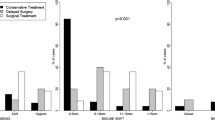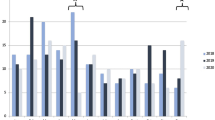Abstract
Objective
We aim to identify the incidence and the characteristics of non-accidental subdural haemorrhage in Hong Kong in children under the age of 5 years.
Method
Eighteen children aged below 5 years presented with subdural haemorrhage without a history of significant trauma were studied. Clinical features and the work-up process for probable child abuse were analysed.
Results
Sixteen combined case conferences were held, and eleven cases were concluded to be genuine child abuse cases of non-accidental head injury (incidence=1.5 per 100,000 children <5 years old per year). Among these cases, the most common presentation in the younger age group (age<1 year) was seizure (5/7), whilst that in the older age group (age 1–4 years) was coma (4/4, two of these patients also had seizure). One patient in the younger age group and three (3/4) of the older age group were found to have multiple unexplained bruises, suggesting that, in older children, direct impact injury played an important role. Five (5/7) children in the younger age group and all four children in the older age group had retinal haemorrhage. Coma on admission was associated with an unfavourable outcome (6/7 vs 0/4, p=0.015).
Conclusions
Sixty-one percent of childhood subdural haemorrhage (11/18) without a history of significant trauma were genuine child abuse cases and should all be investigated for probable “non-accidental injury”. An organised protocol involving a multi-disciplinary team is mandatory.
Similar content being viewed by others

References
Aoki N, Masuzawa H (1984) Infantile acute subdural haematoma—clinical analysis of 26 cases. J Neurosurg 61:273–280
Aoki N, Masuzawa H (1986) Subdural haematoma in abused children: report of six cases from Japan. Neurosurgery 18:475–477
Caffey J (1972) On the theory and practice of shaking infants: its potential residual effects of permanent brain damage and mental retardation. Am J Dis Child 124:161–169
Census and Statistics Department (1997) 1996 population by-census—main report. Hong Kong Government Printers, Hong Kong
Child Protection Registry (1999, 2000, 2001) Statistical report 1998, 1999, 2000. Hong Kong Social Welfare Department
Dias MS, Backstrom J, Falk M, Li V (1998) Serial radiography in the infant shaken impact syndrome. Pediatr Neurosurg 29:77–85
Duhaime AC, Alario AJ, Lewander WJ, Schut L, Sutton LN, Seidl TS, Nudelman S, Budenz D, Hertle R, Tsiaras W, Loporchio S (1992) Head injury in very young children: mechanisms, injury types, and ophthalmologic findings in 100 hospitalized patients younger than 2 years of age. Pediatrics 90:179–185
Duhaime AC, Christian CW, Rorke LB, Zimmerman RA (1998) Current concepts: nonaccidental head injury in infants—the “shaken-baby syndrome”. N Engl J Med 338:1822–1829
Editorial (1998) Shaken babies. Lancet 352:335
Geddes JF, Hackshaw AK, Vowles GH, Nickols CD, Whitwell HL (2001) Neuropathology of inflicted head injury in children. I: patterns of brain damage. Brain 124:1290–1298
Goetting MG, Sowa B (1990) Retinal hemorrhage after cardiopulmonary resuscitation in children: an etiologic reevaluation. Pediatrics 85:585–588
Hsiang JN, Goh KY, Zhu XL, Poon WS (1996) Features of pediatric head injury in Hong Kong. Childs Nerv Syst 12:611–614
Jayawant S, Rawlinson A, Gibbon F, Price J, Schulte J, Sharples P, Sibert JR, Kemp AM (1998) Subdural haemorrhages in infants: population based study. BMJ 317:1558–1561
Kempe CH, Silverman FN, Steele BF, Droegemueller W, Silver HK (1962) The battered-child syndrome. JAMA 181:17–24
Lee AC, So KT, Fong D, Luk SH (1999) The shaken baby syndrome: review of 10 cases. HKMJ Hong Kong Med J 5:337–341
Lloyd B (1998) Subdural haemorrhage in infants—almost all are due to abuse but abuse is often not recognized. BMJ 317:1538–1539
Platt JH (1999) A pitfall in the diagnosis of child abuse: external hydrocephalus, subdural hematoma, and retinal hemorrhages. Neurosurg Focus 7(4):Article 4
Ryan CA, Gayle M (1992) Vitamin K deficiency, intracranial hemorrhage, and a subgaleal hematoma: a fatal combination. Pediatr Emerg Care 8:143–145
Wenstrup RJ, Willing MC, Starman BJ, Byers PH (1990) Distinct biochemical phenotypes predict clinical severity in nonlethal variants of osteogenesis imperfecta. Am J Hum Genet 46:975–982
Yoffe G, Buchanan GR (1988) Intracranial hemorrhage in newborn and young infants with hemophilia. J Pediatr 113:333–336
Author information
Authors and Affiliations
Corresponding author
Rights and permissions
About this article
Cite this article
Sun, D.T.F., Zhu, X.L. & Poon, W.S. Non-accidental subdural haemorrhage in Hong Kong: incidence, clinical features, management and outcome. Childs Nerv Syst 22, 593–598 (2006). https://doi.org/10.1007/s00381-006-0094-7
Received:
Published:
Issue Date:
DOI: https://doi.org/10.1007/s00381-006-0094-7



